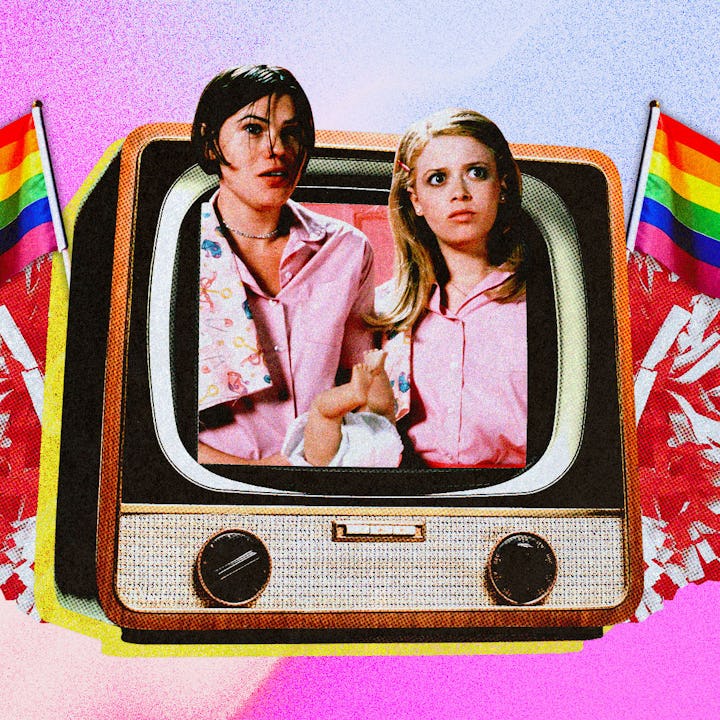Why ‘But I’m A Cheerleader’ Is the Queer Camp We Need Right Now
It is so on point.

I first watched the movie But I’m a Cheerleader roughly 20 years ago. The movie came out in 1999 but it was a couple of years before I saw it for the first time. While I had been out for several years to some people, by the time I saw it I was newly out to everyone. I had just graduated from college and was living in my first real apartment with my then-girlfriend. I was living in a new place, meeting new people, and figuring out how to navigate life without school, and learning how to be comfortable in a heteronormative adult world.
I don’t remember how I stumbled upon it, but I’m so glad I did. Not only was it like nothing I had seen before in terms of queer representation, but its style was so distinct. Filmmaker Jamie Babbit was very intentional with the use of blues and pinks to emphasize gender stereotypes. And the set was almost dollhouse-like to show the very real pretend play of trying to be straight.
In the movie, Megan (Natasha Lyonne), is, well, a cheerleader. She has a boyfriend. But she also has a lot of pictures of girls in her locker. This and her lack of sexual desire for her boyfriend make her parents and friends conclude that she’s gay, so her parents send her to True Directions, a camp to fix “homosexual misfits.” Megan is confused and in denial and claims, “But I’m a cheerleader,” as if that is proof of her heterosexuality. But her attraction to Graham (Clea DuVall) is proof that Megan’s queerness is as much a part of her as her pom-poms.
The movie is a satirical look at homosexuality, teenage identity, and homophobia. It’s full of stereotypes — regarding both how gay people act and how religion and heteronormative thinking force people back into the closet — but where there is smoke, there is flaming queerness and bigotry.
Watching this movie 20 years ago was like having a secret handshake or inside joke with someone. But I’m a Cheerleader was the movie that made me feel seen and understood. It wasn’t just a wink and a nod, it was a, Holy sh*t, yes, that. For so long I had been forced and persuaded in similar ways to “dress like a girl,” fall in love with a man, to live a “normal” life. I knew all of the ways those demands didn’t work for me, but to have a movie articulate those reasons was validation.
And it’s a movie that we need more than ever, because people still need that validation.
Cast members Lyonne, DuVall, Michelle Williams, RuPaul, and Melanie Lynskey are just some of the notables that are still in the spotlight and who only get better as they age. Not only have they gotten better as actors, but they have become louder in their queerness and allyship. Both are very much needed now.
There are moments when I feel both pleasantly surprised, even hopeful, when it comes to overall acceptance and the increasing number of people identifying as LGBTQIA+ (16% of Gen Z identify as LGBTQ). But there continues to be a very loud part of our population who support and empower the people actively taking away LGBTQIA+ rights. They are taking away books, sports, gender affirming care, or removing them from homes of supportive parents.
The argument “but you’re just a kid” never seems to be applied to a child who says they’re straight or cisgender. Nor does it make any more sense when a lesbian tries to convince anyone of her sexuality by reminding everyone that she is a cheerleader. It’s the central premise of the movie, played for laughs but also important and absolutely serious: yeah, she’s a cheerleader, but that doesn’t mean she’s doing it for the male gaze or that something perceived as so feminine can’t also be queer. One has nothing to do with the other. I won’t give away the ending, but you’ll get your proof.
Which is why But I’m a Cheerleader is so on point. We are who we are. No amount of prayer or intimidation can change that. People can make our lives harder and scarier, but we’re resilient and can find queer joy in the darkest places. Or if you’re Graham and Megan you find it while scrubbing a floor at a camp meant to force you into heteronormativity. They’re supposed to be learning the duties of keeping a house clean, but the sexual tension between them could have melted whatever grime was caked on the floor — no Pine Sol needed.
The bigotry that the queer community is facing right now is no joke, but the absolute hypocrisy and ridiculous entitlement people have when they assume to know what’s best for us is laughable.
Just watch it. It’s really hard to make a funny and heartwarming movie about forcing gay kids to not be gay, lest they face total rejection from their family, but writers Brian Peterson and Jamie Babbit (who also directed the movie as well as the Amazon series A League of Their Own) made it look easy.
Amber Leventry is a queer, nonbinary writer and advocate. They live in Vermont and have three kids. Amber’s writing appears in many places including The Washington Post, Romper, Grown and Flown, Longreads, The Temper, and Parents. Follow them on Twitter and Instagram @amberleventry and reach out to hire them for speaking engagements and LGBTQIA+ training sessions.
This article was originally published on